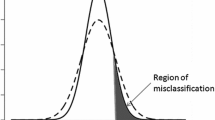Abstract
A new formula is developed for the relative efficiency of two tests measuring the same trait. The formula expresses relative efficiency solely in terms of the standard errors of measurement and, surprisingly, the frequency distributions of true scores. Approximate methods for estimating relative efficiency may make this function routinely available. A numerical illustration compares new and old estimates of relative efficiency for subtests from the Scholastic Aptitude Test.
Similar content being viewed by others
References
Birnbaum, A. Some latent trait models and their use in inferring an examinee's ability. In F. M. Lord and M. R. Novick,Statistical theories of mental test scores. Reading, Mass.: Addison-Wesley, 1968. Pp. 453–479.
Brogden, H. E. New problems for old solutions.Psychometrika, 1957,22, 301–309.
Kendall, M. G. and Stuart, A.The advanced theory of statistics. Vol. 2, New York: Hafner, 1961.
Lord, F. M. A theory of test scores.Psychometric Monograph No. 7. Psychometric Society, 1952.
Lord, F. M. A strong true-score theory, with applications.Psychometrika, 1965,30, 239–270.
Lord, F. M. Estimating true-score distributions in psychological testing (an empirical Bayes estimation problem).Psychometrika, 1969,34, 259–299.
Lord, F. M. Tailored testing, an application of stochastic approximation.Journal of the American Statistical Association, 1971,66, 707–711.
Lord, F. M. Estimation of latent ability and item parameters when there are omitted responses.Psychometrika, 1974, in press. (a)
Lord, F. M. Quick estimates of the relative efficiency of two tests as a function of ability level.Journal of Educational Measurement, 1974, in press. (b)
Rao, C. R.Linear statistical inference and its applications. New York: Wiley, 1965.
Stocking, M., Wingersky, M. S., Lees, D. M., Lennon, V. and Lord, F. M. A program for estimating the relative efficiency of tests at various ability levels, for equating true scores, and for predicting bivariate distributions of observed scores. Research Memorandum 73-24. Princeton, N. J.: Educational Testing Service, 1973.
Wingersky, M. S., Lees, D. M., Lennon, V. and Lord, F. M. A computer program for estimating true-score distributions and graduating observed-score distributions.Educational and Psychological Measurement, 1969,29, 689–692.
Author information
Authors and Affiliations
Additional information
Research reported in this paper has been supported by grant GB-32781X from National Science Foundation.
Rights and permissions
About this article
Cite this article
Lord, F.M. The relative efficiency of two tests as a function of ability level. Psychometrika 39, 351–358 (1974). https://doi.org/10.1007/BF02291708
Received:
Revised:
Issue Date:
DOI: https://doi.org/10.1007/BF02291708




